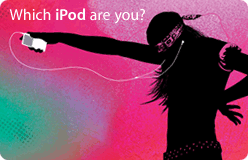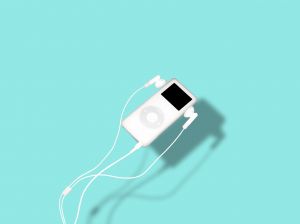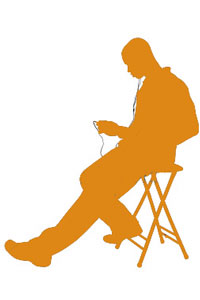iPods for Learning
Unlike a lot of fads, such as Hula Hoops and Pet Rocks, an iPod can have a long-term affect on learning as it is no longer just a sound machine for listening to music, but rather an information delivery device, thanks to podcasts; in addition to storing and viewing photos, notes, and electronic books. Schools such as Duke University, Georgia College & State University, and North Carolina State University see iPods as a learning tool. Duke University passed out free iPods to its new freshmen to be used as high-tech educational tools to record lectures, capture scientific data, and play language-training recordings. GCSU has used them in a variety of projects. While NCSU uses them as a lecturing device to relieve some of the pressure off its overcrowded classrooms.
 Recently, a communication technologies class at Marymount Manhattan College created audio guides to nine Museum of Modern Art paintings. They're part of a project on how new technology empowers people to break free of traditional media, in this case the museum's own human guides.
Recently, a communication technologies class at Marymount Manhattan College created audio guides to nine Museum of Modern Art paintings. They're part of a project on how new technology empowers people to break free of traditional media, in this case the museum's own human guides.
What is most interesting about the iPod is that there are not only a lot of learning professionals who see its potential as a learning device, but also a whole army of listeners (potential learners) who love listening to it. And with its strong sales, this army of listeners/learners is a growing one.
Unlike some of the other technologies, such as computer simulations, a podcast or audio production can be fairly simple to produce. For example, shortly after elearning became more than a buzzword, people were complaining that most of it was nothing more than page-turners. That is, it was simply easier and quicker to produce some electronic text than to produce true interactive media.
These devices have several unique features for intriguing educational opportunities. Klopfer, Squire, & Jenkins (2002) describe five properties of them:
- Portability - can take to different sites and move around within a location
- Social Interactivity - can exchange data and collaborate with other people
- Context Sensitivity - can gather data unique to the current location, environment, and time
- Connectivity - can connect handhelds to personal computers to create a true shared environment
- Individuality - can provide unique scaffolding that is customized to the individual's path of investigation.
So, is there any value of using iPods in corporate training or are they just simply ear-turners? As the higher institutes of learning have shown, iPods are not replacements for learning, but are rather tools to aid in the learning process. Their biggest value is that they allow learners to shift time by listening to audio or audio/visual recordings at their own choosing. Rather than being at a appointed place, iPods, being quite portable, allow learners to choose when they are best able to learn. For example, I normally go for a long walk every afternoon. I have found this to be a perfect time to listen to podcasts.
For example, you could place an audio and visual guide of your organization on iPods and send new hires on a tour of their own (just like the Museum of Modern Art does), rather than having them waiting for an orientation class and then sitting through a dry PowerPoint presentation. Or perhaps record a step-by-step procedure of a task, along with a pictures, maps, charts, and notes to an iPod and use it as a training device.
Podcasting
Podcasting can be viewed as another variant of mLearning (mobile learning). When video is used in a podcast, the term “vodcasting” is sometimes used.
Adam Curry of the Daily Source Code is believed to have coined the term “podcast,” an amalgamation of two other words: iPod and broadcast. However, the pod is a bit of a misnomer as podcasts can be played back on not only iPods, but also most computers and mp3 players.
Podcasting is a method of distributing multimedia files, normally audio or video files, over the Internet by using either the RSS or Atom syndication formats. But instead of pushing text from blogs and news sites to various content aggregators, such as Wordpress and Bloglines, podcasting sends audio content directly to an iPod or other MP3 player.
“It's aggregating audio content, but it's taking one extra step, in that it's putting it on your device,” said Adam Curry in a Wired article, who built the first podcasting aggregator, known as iPodder. “Not only do these devices play it, but you don't have to put it there yourself. It just happens automatically.”

Thus the main difference between an audio file and a podcast is that with an audio file, you normally have to download it to your computer and then to your iPod or mp3 player. Whereas a podcast is automatically sent to your computer (iTunes if you use an iPod). When you plug the iPod into your computer to recharge the battery, the podcasts are then automatically transferred to it.
As a side note, the editors of the New Oxford American Dictionary declared podcasting the 2005 word of the year, defining the term as “a digital recording of a radio broadcast or similar program, made available on the Internet for downloading to a personal audio player.”
Media
Marshall McLuhan called radio a hot medium in that it extends one single sense in high definition (filled with data). Thus, a photograph has high definition, while a sketch or cartoon normally has low definition. Low definition media invites participation as you have to fill in the missing pieces, e.g. a telephone or a drawing like the one below.
High definition media creates a private experience, such as viewing a photograph or listening to an iPod or radio. A book is also normally high-definition. It provides even more data than listening as most people can read a lot faster than a good speaker can talk. Yet the context is quite different. When you have a thought while reading, you pause, reflect, and then continue reading. The data simply comes too fast to try to do both reading and reflecting at the same time. If one tries to do another task while reading, the mind tends to zone out to what is known as mindless reading.
However, when listening, one can reflect over what was said, yet still remain fairly connected to the present speech because people talk slower than most people can read, thus the data comes at a much slower pace.
McLuhan (1964) describes an experiment performed in Toronto in which various groups of students learned via a lecture, television, or radio. When tested, the students who listened to the radio outperformed the students who attended a lecture or watched a TV program. Now I would venture to say that depending upon the task or subject matter at hand, either a high, low or a combination of both definitions might be best.
But what is most interesting, is that the market has shown a desire for a high definition medium, and unlike radio, which was out of the reach of most trainers to use as a learning device, the iPod has provided us with a cost-effective learning tool to reach out not only to this market, but also provide a method for creating another learning method—a true personal experience.
Learning from Listening
 The medium has little affect on how people learn—the methodologies are far more important than the media when it comes to learning (Clark, 2001). The media is simply the vehicle or transporter of the learning methods. For example, if used in the same manner as in a museum tour, the iPod simply becomes the guide. The real learning comes from the experiences that the iPod veers you to, such as interacting with someone when led to a cubicle or department, to an activity that helps you to learn some aspect of your job, and finally learning of your new surroundings in order to paint a picture of the whole. When it comes to learning, it is far more important with what you do with the media that surrounds you, rather than what you think that a particular medium is capable of doing to you.
The medium has little affect on how people learn—the methodologies are far more important than the media when it comes to learning (Clark, 2001). The media is simply the vehicle or transporter of the learning methods. For example, if used in the same manner as in a museum tour, the iPod simply becomes the guide. The real learning comes from the experiences that the iPod veers you to, such as interacting with someone when led to a cubicle or department, to an activity that helps you to learn some aspect of your job, and finally learning of your new surroundings in order to paint a picture of the whole. When it comes to learning, it is far more important with what you do with the media that surrounds you, rather than what you think that a particular medium is capable of doing to you.
Leonardo Dicaprio Tasks
Jared Spool wrote a story that is quite relevant. As each learner files into the classroom and sits down in front of a computer with a browser and internet connection, you give all of them the same task: “Pretend you're interested in Leonardo DiCaprio. Find something out about him that you don't already know.”
Now, imagine what you would do if you were asked to perform that task. If you have no real interest in Mr. DiCaprio's life, you might enter his name into the search box and declare the task done on the first page you find with any real substance. The task would only take a few moments to complete.
However, someone with a deep interest in Leo's world might spend more time on the task. They would dismiss any information they already knew and hone in on content that was truly new and unique. We'd expect to see a completely different behavior from this person.
A person's passion about a subject changes how they invest their time for such tasks. Thus, listening to a podcast or audio file can be just as effective as other media if the learner is passionate about it and if the learning designer has built in some good learning activities.
Informal Learning and Podcasts
 A typical podcast is not normally considered training or formal learning, but rather informal learning. However, to most learners, I don't think they see any real difference as they are more interested in what they learn and how that learning can help them to achieve their goals rather than defining the terms and limits of training. And to them, informal learning can be just as important, if not more important, than any formal learning. Training is typically composed of standards and procedures that the organization wants its employees to follow; whereas informal learning most often presents itself to the learner as real empowerment.
A typical podcast is not normally considered training or formal learning, but rather informal learning. However, to most learners, I don't think they see any real difference as they are more interested in what they learn and how that learning can help them to achieve their goals rather than defining the terms and limits of training. And to them, informal learning can be just as important, if not more important, than any formal learning. Training is typically composed of standards and procedures that the organization wants its employees to follow; whereas informal learning most often presents itself to the learner as real empowerment.
Although standards and procedures are often quite important for the survival of the organization, in addition to supplying the building blocks of a knowledge base, they still represent the beliefs of others for best accomplishing a task or job. Often, it is the informal learning opportunities that allow the learner to extend her formal knowledge base into thought and action that goes beyond established procedures.
Semour Papert once said something to the effect that anything is easy if you can assimilate it to your collection of models. Thus for designers to see podcasts as a learning tool, then they must expand their set of models. Design guru John Thackara wrote that new technology normally works best when helping people to interact across time, rather than space. For example, it is helpful that I can listen to podcast from experts from any place. But what truly makes them invaluable is the ability to shift them to a time that suits me, thus I get an instant knowledge network principally on my own making.
Almost every podcast is created by its author to start a relationship between the author and the audience, rather than as a way to make money. In addition, these podcast are often tied to a blog, which redefines the learning process from a point-to-mass service to an ecology in which time and knowledge flow in many different directions. While there are blogs that draw huge numbers of readers, the majority are small ones with a select readership. The blog/podcast author is able to interact with the readers, in addition to pointing them to other relevant posts in other blogs as they occur. While far from perfect (content, along with the possibility of discussion, tends to get buried deep within the blog), they do allow for attention, interaction, and the opportunity to discover new insights.
Now if you are a trainer or teacher who loves the classroom, I would not worry about your job. Radio, television, video, CBT, etc. have all lined up to take your place. . . yet it never does for it simply cannot compete with the live experience and discussions that take place between the instructors and learners. We simply seem to thrive in this type of learning environment. We keep on hearing that the end of the classroom is nearing, yet with all the competition that the internet has brought, the classroom still remains a strong, viable competitor to any new technology. So I would look at the podcast and iPod as an extension of the learning environment, rather than as a replacement.
Case Study
Listening to heart sounds is a skill doctors are quickly losing. Dr. Michael Barrett of Temple University concluded that medical students improved their stethoscope skills dramatically if they listened to certain digitally recorded soundtracks that mimic the distinctive vibrations produced by various valve problems and other cardiac conditions.
Through trial and error, Barrett discovered that you have to listen to a recording about 500 times to reliably discriminate between the different sounds made by various heart problems. Barrett produced a CD that mimicked the sounds of six abnormal heart conditions and gave it to a group of medical students, who promptly uploaded the recordings to their iPods. About two hours and 3,000 playbacks later, the students were able to correctly identify 80% of the heart sounds on a test-up from 30% before the practice listening session.
The full Times story is here. Temple University's story of Dr. Barrett's story can be read here, which includes a couple of mp3s of heart sounds.
Learning Potentials
Listening to digital audio content won't replace reading, listening to live presentations, or the multitude of other ways learners take in information, but it can augment many learning methodologies. For example:
- Using a podcast to help guide new hires around the organization, such as the Museum of Modern Art does.
- Describe and showing (many iPods can display picture) new products in order to train the sales staff.
- Recording step-by-step procedures to guide learners.
- Recording lectures so that learners can listen to them any time, any where.
Music, learning, and iPods
While Instructional Designers are more likely to be looking at iPods for their ability to help people learn through podcasts, they should not forget what iPods were originally designed for — music, which can be invaluable in the learning process (Songs for Teaching).
If you need royalty free music for transitions in your podcasts, then these sites should be of interest: The Music Bakery, Stock Music at Foto Search, and Free Music Archive.
Podcasts
A couple of podcasts that might be of interest to some of the readers:
Cult of the iPod (mp3)
Social Networks and future web technology (mp3)
Nerve Endings and the Discovery of the Synapse (mp3)
References
Clark, Richard (2001). Learning from Media: Arguments, Analysis, and Evidence. Greenwich, Connecticut: Information Age Publishing.
Klopfer, E., K. Squire & H. Jenkins (2002). Environmental detectives PDAs as a window into a virtual simulated world. Paper presented at International Workshop on Wireless and Mobile Technologies in Education.
McLuhan, Marshall (1964). Understanding Media: The Extensions of Man. Massachusetts: First MIT Press.



